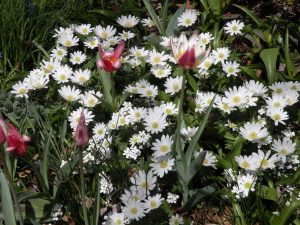
Anemone blanda ‘White Splendour’, Tulipa ‘Heart’s Delight’
Why am I writing now about bulbs that bloom in the Spring? Because it’s not too late to plant. In fact, now is the ideal time for bulbs to root. Temperatures that are too warm might inspire them to try to bloom too soon.
Most of us love tulips but so do the deer. I was so frustrated last year. Just as my tulips were coming into bloom, boom! They were gone. Lovely stalks but nothing above them. Fortunately, I discovered I Must Garden Deer Repellent. I sprayed the remaining buds and watched carefully for emerging buds so that I could spray them as well. I’m here to tell you that this spray works and that it doesn’t make you to throw up because the scent is mint or spice. You do have to be vigilant and watch for emerging buds but I think it also helps to spray the leaves as soon they appear.
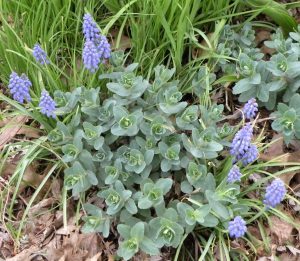
Plant small bulbs like Muscari among perennials that won’t be fully foliated yet such as Sedum ‘Strawberries and Cream’
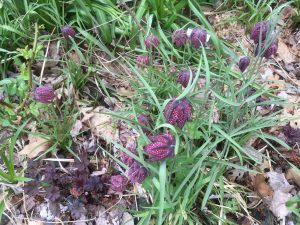
The color of Fritillaria meleagris echoes that of a purple Heuchera planted near by.
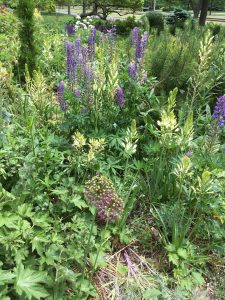
Ornithogalum magnum with lupines
For those of you who don’t want to be bothered with spraying, there are many other spring-flowering bulbs that the deer don’t touch: Eranthis (Winter Aconite), Galanthus (Snowdrops), Scilla sibirica (Squill), Chionodoxa (Glory-of-the-Snow), Hyacinthus, Muscari (Grape Hyacinth), alliums (don’t forget the little ones that naturalize), Anemone blanda, Leucojum aestivum (Summer Snowflake), Fritillaria (Guinea Flower) and Ornithogalum (Star -of-Bethlehem). The deer won’t eat Crocus but the rabbits and the squirrels might but for some reason, they seem to leave Crocus tommasinanus alone. I have found that Turface, an inorganic grit, shaken oven bulbs before covering them with soil, seems to inhibit burrowing animals.
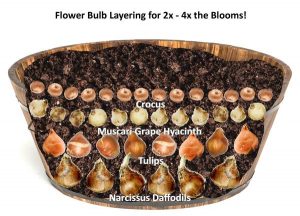
Bulb layering shown for a container but the principle is the same for in ground planting.
Make the most of your space. Layer your bulbs. Plant large bulbs like Narcissus, tulips, and hyacinths six inches deep, cover with a few inches of soil and Turface; then, plant medium bulbs such as Crocus, Allium atropureum and nigrum; lastly, after covering those bulbs with soil and Turface, plant the tiny ones like Eranthis and Galanthus.
If you decide you don’t want to plant this fall, make a note on your 2021 calendar to start observing your garden from February on, watching to see where bulbs would make a difference had you planted them. Then you will have the information you need to order next summer for 2021 fall planting. If you plant all of the bulbs I’ve mentioned, you could have color in your gardens from late February/early March until early June.


2 Comments